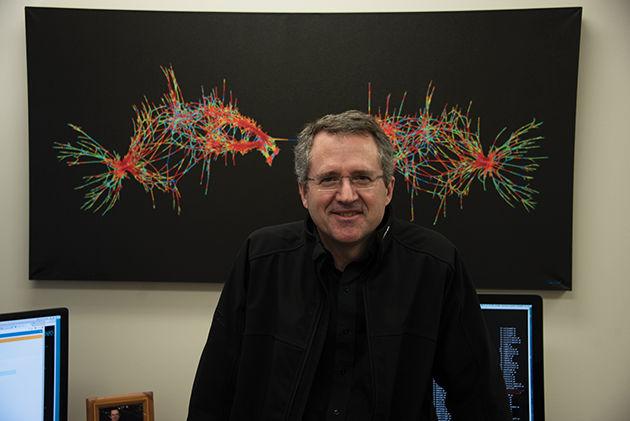Sparse matrix algorithms are behind many of the everyday tools used by people around the world. They are used in Google Street View, Google Earth, engineering simulations, financial markets and power systems. Tim Davis, A&M professor in computer science and engineering and a renowned expert in sparse matrix computations and creator of SuiteSparse, found another use: Creating works of electronic art by visualizing music.
Davis said the algorithms he develops are used to operate on matrices used in different applications. These matrices are not random blocks of data, but have structure to them. Davis collects these matrices from real applications and tests the algorithms to develop benchmarks.
“I have a collection of matrices that is used widely by researchers like me to test their methods,” Davis said. “To understand these problems better we draw them, we convert these matrices to graphs and draw the graphs.”
Davis said fastcompany.com featured these visualizations on how science problems also yielded beautiful art, catching the attention of the organizers of the London Electronics Arts Festival.
“I thought, this is not music these are matrices; that is kind of the thing that went through my mind,” Davis said.
Davis said graphs can be imagined as nodes that are connected by edges. He described his moment of inspiration as a combination of his knowledge on graphs, mathematics and music.
“I know how to take music, I can find relationships in the music and I could create a graph from the music and if the music has got regular beats I could get a mesh; and meshes are pretty, and if it is meshes are pretty, and if it is complex who knows what I could get,” Davis said. “One week later I had the artwork that eventually all over on billboards in London advertising the festival.”
Davis said there have been efforts by other researchers and artists to go in the reverse direction and use mathematical rules to generate music. There also exists a whole branch of music visualization, where a snapshot of the image being rendered was instantaneous, but Davis’ algorithms work differently.
“What you are seeing here is rendering the entire piece of music in a single image,” Davis said.
Yifan Hu, principal research scientist at Yahoo Research said he has used Davis’ matrices to test his visualization algorithms that led to a collaboration and papers. The graphviz algorithm utilized by Davis was originally developed by AT&T labs and was expanded by Hu to handle much larger graphs.
“Graphviz basically turns a mathematical description of graph, to a visualization of nodes and edges — a node is a point and edge is a line,” Hu said. “You can see structures, patterns and anomalies in your relational data.”
Davis’ research has resulted in not only creating new algorithms, but also new software. Davis said to convert his algorithms to usable tools, voluminous code needs to be generated which needs to be perfect without any bugs. He said the code he creates is a published artifact and is peer reviewed by journals.
“I love creating new algorithms and new theory, though I also love writing code,” Davis said. “And it has to be perfect. I have this intense drive to make it perfect, and to make it perfect it has to be in some aesthetic sense beautiful in my own mind.”
Davis said the art comes in several places, including creating the rules to render the music, writing the code to implement the rules and then selection from the vast space of renderingsgenerated.
“I will generate a vast landscape, thousands upon thousands of images and then I will go manually through them, and say, ‘Oh yeah, this renders the music well; this is beautiful,’” Davis said.
Juan Rey, senior engineering director at Mentor Graphics, has been collaborating with Davis since 2013 on solving large sparse matrix problems, during the course of which he became familiar with Davis’ artwork. Rey commissioned the creation of a visualization based off music composed by biologists he liked from Patagonia in Argentina.
“I got very much fascinated by learning more about the algorithms he has been developing to create these unique representations of music,” Rey said. “I was very pleased with the work that he did.”
Davis said he does not claim the uniqueness of the rendering of the music, but more as an artistic interpretation of the music.
“My tool is not a paintbrush, it‘s an algorithm and Matlab — it’s math,” Davis said.
Seeing sound
March 20, 2017
Donate to The Battalion
Your donation will support the student journalists of Texas A&M University - College Station. Your contribution will allow us to purchase equipment and cover our annual website hosting costs.























